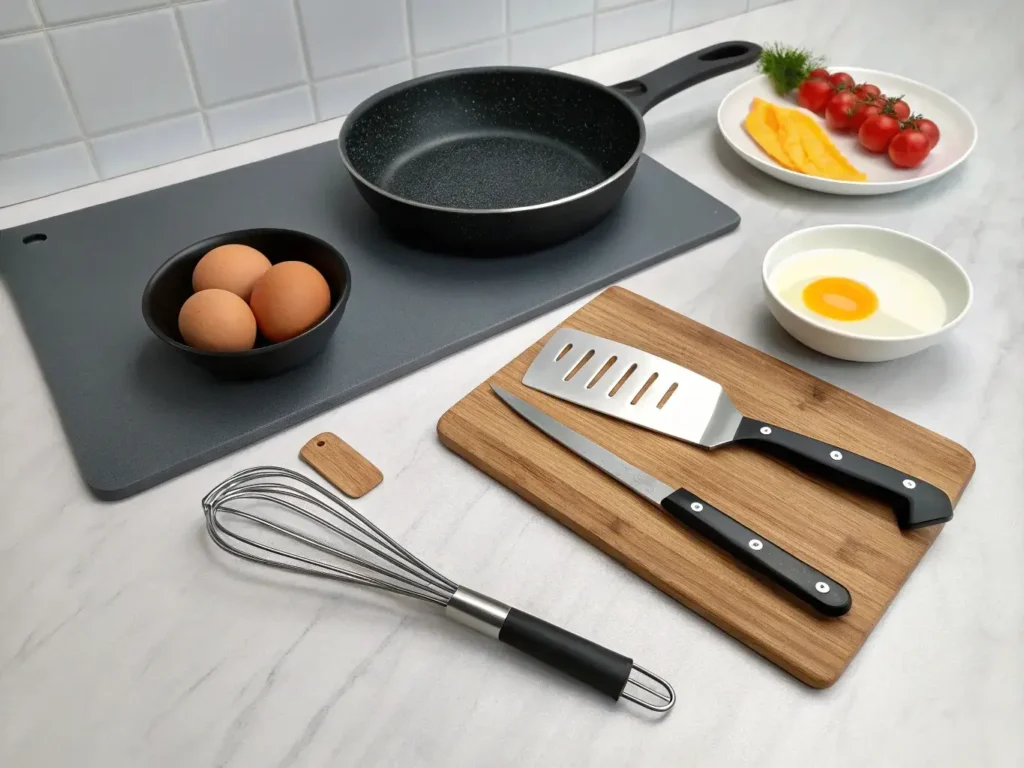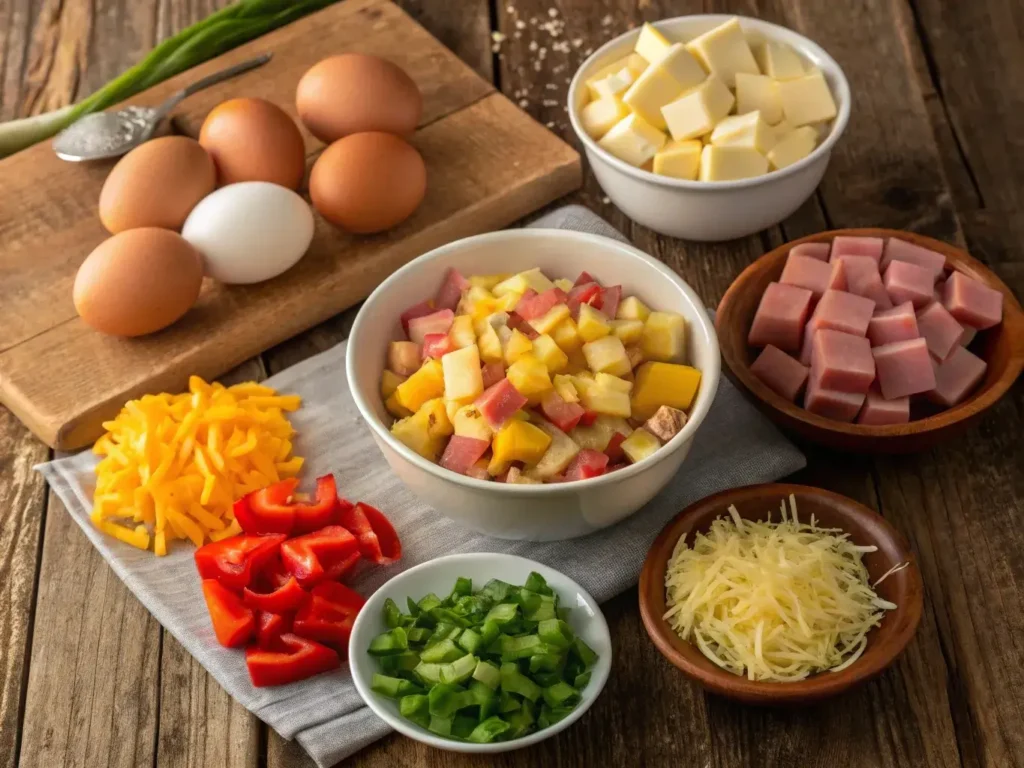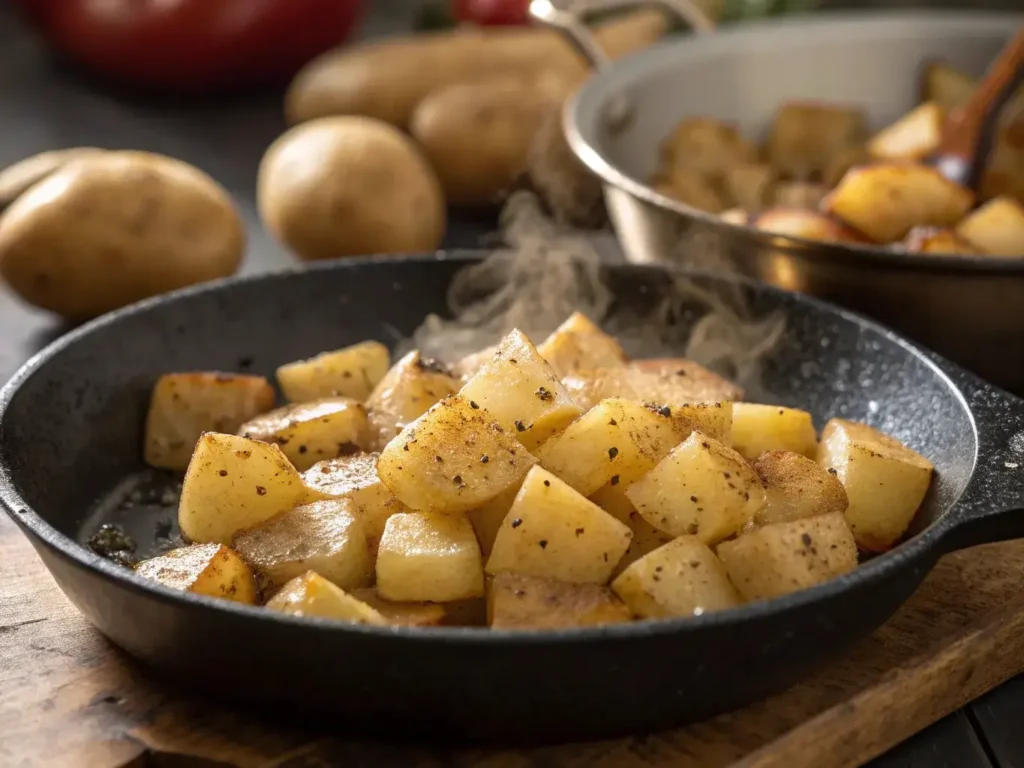Are you craving a hearty breakfast that bursts with flavor in every bite? Look no further, because this denver omelette with cheese and potatoes delivers a savory, satisfying meal that you can whip up in no time. Whether you are brand-new to cooking eggs or you already consider yourself an omelette master, this recipe will help you create a fluffy, cheesy, and perfectly cooked dish. In this guide, you will learn not only how to prepare this beloved breakfast staple but also how to customize, serve, and troubleshoot it to fit any occasion.
1. Why Denver Omelette with Cheese & Potatoes Is Your Next Must-Try
A Brief History of This Cheesy Delight
The Denver omelette is thought to have evolved from the Western sandwich, which traditionally involved chopped ham, onions, and bell peppers. Over time, inventive cooks started mixing these ingredients with eggs. However, you might be wondering how cheese and potatoes came into play. Many home cooks soon realized that adding gooey cheese enhanced the omelette’s creaminess, while potatoes provided a hearty boost. Thus, the denver omelette with cheese and potatoes was born, offering a filling and flavorful twist on a breakfast classic.
In addition, historians believe that the “Denver” name became popularized out West, although the exact origin story remains a bit fuzzy. Despite this mystery, one thing is certain: the combination of soft eggs, melted cheese, tender potatoes, and crisp veggies will transport you to breakfast heaven.
Essential Kitchen Tools for Your Cheese and Potato Omelet

When it comes to making a fluffy omelette, having a few key kitchen tools will greatly improve your experience. Therefore, consider gathering these before you get started:
- Nonstick skillet or well-seasoned cast-iron pan (8–10 inches)
- Silicone or rubber spatula to gently lift and fold the omelette
- Sharp chef’s knife or paring knife for dicing vegetables
- Cutting board with a stable surface
- Whisk or fork for beating the eggs
Moreover, you will want to make sure your workspace is tidy and well-organized because this will help you move smoothly through each step of the cooking process.
Choosing the Freshest Ingredients
You can’t create a great cheese and potato omelette without fresh, high-quality ingredients. Thus, if possible, purchase your eggs, cheese, and produce locally. Look for:
- Eggs: The fresher, the better. Check the sell-by date and ensure there are no cracks.
- Cheese: Sharp cheddar, pepper jack, or Swiss are popular choices. However, feel free to experiment with Gouda or feta for a different flavor profile.
- Potatoes: Russet or Yukon Gold potatoes work best since they hold up well in the skillet.
- Veggies: Bell peppers and onions are classic. On the other hand, you can also add mushrooms, spinach, or zucchini for variety.
- Ham or Bacon (Optional): Use a good-quality deli ham or bacon, if desired, for that meaty touch.
According to the Egg Nutrition Center, eggs are a valuable source of high-quality protein and nutrients like vitamin D and choline, so you can feel good about enjoying them regularly.
Setting the Stage: Preparing Your Workspace
Before you start cooking, make sure you have everything laid out within arm’s reach. In addition, pre-measure your ingredients:
- Dice your potatoes, peppers, and onions.
- Grate your cheese.
- Beat your eggs in a bowl with a dash of salt and pepper.
A clean and organized workspace not only makes the process more enjoyable but also helps ensure you don’t miss a crucial ingredient. Therefore, you’ll have a stress-free cooking experience from start to finish.
2. Key Steps for a Fluffy Denver Omelette with Cheese and Potatoes

If you’re excited to cook an irresistible denver-style omelette with cheese and potatoes, then you’re in the right place. Below is a thorough process with time-saving tips and visuals in mind. Remember: This dish is easy to customize, so feel free to adjust the ratio of potatoes, cheese, and veggies according to your preference.
For another delicious breakfast recipe, check out our Sweet Potato Bread from Scratch to pair with your omelette!
Gathering & Measuring Your Ingredients
It’s essential to measure your ingredients accurately to achieve consistent results. Thus, consider the following standard quantities for one generous serving:
- 3 large eggs
- 1/2 cup diced potatoes (Yukon Gold or Russet)
- 1/4 cup diced bell peppers (mixed colors for variety)
- 1/4 cup diced onions (yellow, white, or red)
- 1/4–1/2 cup shredded cheese (Cheddar, Gouda, or Swiss)
- 2 tablespoons ham or bacon bits (optional)
- 1 tablespoon cooking oil or butter
- Salt and pepper to taste
In addition, keep an extra pinch of cheese on hand to sprinkle on top just before serving.
Cooking the Potatoes for Optimal Texture

Most people underestimate the importance of properly cooking the potatoes. However, this step can make or break your omelette:
- Preheat your skillet over medium heat and add the oil or butter.
- Sauté diced potatoes for 5–7 minutes, stirring occasionally.
- Add a pinch of salt and pepper, plus any herbs you love (e.g., rosemary or thyme).
- Check tenderness by piercing a potato cube with a fork; it should go through easily, but the potatoes should still hold their shape.
Therefore, allow the potatoes to form a light golden crust for added flavor. If you like softer potatoes, add a splash of water and cover the pan briefly to steam them.
Building the Perfect Omelette Filling
Once the potatoes are partially cooked, it’s time to add your veggies and optional ham or bacon bits:
- Add bell peppers and onions to the same skillet. Cook for an additional 3–4 minutes until onions become translucent.
- Stir in ham or bacon bits (if using) and continue cooking for another minute.
- Season with a little more salt and pepper, tasting as you go.
- Remove the filling from the skillet and set aside in a small bowl.
Moreover, if you like a spicier kick, toss in diced jalapeños or a dash of chili flakes at this stage. This approach ensures maximum flavor infusion without overwhelming the rest of the omelette.
Mastering the Fold & Final Touches
Now for the fun part: cooking and folding the eggs into a fluffy masterpiece.
- Lower the heat to medium-low and coat the skillet with fresh oil or butter, ensuring it’s evenly distributed.
- Pour beaten eggs into the warm pan and let them settle for a few seconds.
- Use a silicone spatula to gently pull the edges of the eggs toward the center, allowing uncooked egg to flow underneath.
- Sprinkle half of your shredded cheese on the partially set eggs, followed by the potato and veggie mixture. Then add the remaining cheese on top.
- Fold one side of the omelette over the filling. Continue cooking for 1–2 minutes until the eggs are fully set but still soft.
- Slide the omelette onto your plate, seam-side down.
In addition, garnish with fresh herbs like chives or parsley. You can also drizzle hot sauce or salsa on top if you want even more flavor.
3. Variations of a Traditional Cheese and Potato Omelette
Everybody has different dietary preferences and taste buds. Therefore, customizing this omelette with cheese and potatoes ensures that you have the perfect breakfast, brunch, or even dinner.
Vegetarian Twist: Swap Out the Ham
On the other hand, if you skip the ham or bacon, you can still relish the classic flavors in your Denver omelette. Instead, consider adding:
- Mushrooms for an earthy taste
- Spinach for extra nutrients and color
- Tofu crumbles if you want more protein without meat
Thus, vegetarian options don’t have to be boring. You simply need to experiment with ingredients that appeal to you.
Spicy Kick: Adding Jalapeños
If you love a tingle on your tongue, then jalapeños are the way to go. Chop them into small pieces and sauté them alongside the onions and peppers. You might also sprinkle in a little cayenne pepper or a few drops of your favorite hot sauce. Moreover, consider serving your omelette with a side of guacamole or spicy salsa to accentuate the heat.
Cheese Selection: Gouda, Cheddar & More
Although cheddar is traditionally used in many Denver-style omelettes, there are plenty of cheeses to explore:
- Smoked Gouda: Subtle smokiness complements the potatoes.
- Pepper Jack: Lends a bit of spice and melts beautifully.
- Swiss: Offers a mild, nutty flavor.
- Goat Cheese: Creamy tang pairs wonderfully with fresh vegetables.
Therefore, do not limit yourself to just one type of cheese. Mixing a couple of cheeses can yield a unique taste that sets your omelette apart from the rest.
Crispy vs. Soft: Potato Prep Methods
Not everyone likes their potatoes the same way. Therefore, if you prefer a crispier texture, you can par-cook the potatoes and then roast them in the oven with a bit of olive oil at 400°F (200°C) for about 10–15 minutes before adding them to the skillet. On the other hand, if you enjoy a softer bite, simply sauté them in the skillet until tender. Either method will work well; it’s all about personal taste.
4. Serving & Pairing Ideas

Now that your denver omelette with cheese and potatoes is ready, you might be wondering how best to serve it. In addition, pairing the right side dishes and beverages can elevate your meal to a new level of deliciousness.
Classic Sides to Complement Your Omelette
Although an omelette is often a standalone breakfast, there are plenty of simple sides that enhance its flavors. For instance:
- Toast or English muffins with a dab of butter or jam
- Fresh fruit salad or a side of sliced avocado
- Breakfast sausages or turkey bacon for extra protein
- Crisp side salad with a light vinaigrette
These options balance the heartiness of the eggs and potatoes, ensuring a well-rounded meal that satisfies you without being overly heavy.
Beverage Pairings for Any Time of Day
Choosing the right drink can further accentuate the flavors in your omelette. Thus, consider these ideas:
- Orange or grapefruit juice for a bright citrus complement
- Coffee or tea if you prefer a warm morning pick-me-up
- Iced tea or sparkling water on a hot day
- Mimosa or Bloody Mary for a celebratory brunch vibe
On the other hand, if you are hosting a brunch gathering, offering a variety of drink choices will make your guests feel right at home.
Storing & Reheating Leftovers
Sometimes, you may cook more than you can finish. Therefore, you can store leftover omelette in an airtight container for up to two days in the fridge. To reheat:
- Microwave in 20-second increments, checking for warmth.
- Skillet reheat on low heat to maintain the texture.
In addition, if you want to keep the eggs from drying out, add a few drops of water or milk to the container before microwaving.
Elevating Presentation for Special Occasions
Although an omelette is a casual dish, a few presentation tricks can make it more appealing:
- Garnish with fresh herbs like chives, parsley, or cilantro.
- Drizzle with a vibrant sauce (salsa verde or chipotle crema) across the top.
- Sprinkle colorful diced tomatoes or peppers for added visual pop.
- Serve on a warmed plate to maintain optimal temperature.
Therefore, even a simple breakfast can feel like a restaurant-quality meal with a little extra attention to detail.
5. Pro Tips & Troubleshooting
Making a cheese and potato omelette sounds simple, but there are common pitfalls. Thus, these expert strategies will help you master the art of omelette-making.
Avoiding Overcooked Eggs
Eggs can overcook quickly, resulting in a rubbery texture. Therefore:
- Use medium-low heat to allow gentle cooking.
- Remove the omelette from the stovetop just as the eggs begin to firm up.
- Remember that residual heat will continue cooking the eggs for a short period after you remove them from the heat.
Moreover, you can always put the lid on for a minute or two if you prefer a more thoroughly set top layer.
Keeping It Fluffy: Whisking Techniques
The key to a lofty omelette is aerating the eggs. Thus:
- Whisk eggs vigorously for about 30 seconds.
- Incorporate a splash of milk or water to keep the eggs light.
- Avoid beating the eggs too far in advance. Mix them right before pouring into the skillet.
By following these steps, you’ll notice how your omelette remains tender without feeling dense or heavy.
Making It Healthier Without Sacrificing Taste
If you’re watching your calorie intake or simply want a more nutrient-dense meal, consider these adjustments:
- Use egg whites or a mix of whole eggs and egg whites.
- Swap butter for a small amount of olive oil.
- Add more vegetables like spinach, kale, or broccoli.
- Opt for reduced-fat cheese or a smaller quantity of full-fat cheese.
On the other hand, don’t skip flavor boosters like herbs, spices, and a dash of Parmesan sprinkled on top.
Common Mistakes & How to Fix Them
Despite your best efforts, mistakes can still happen. Therefore, here are a few common issues and solutions:
- Eggs stuck to the pan: Make sure you properly grease the skillet and use a nonstick surface.
- Omelette fell apart during the flip: Cook the eggs a bit longer so they set before flipping.
- Under-seasoned dish: Taste as you go, adjusting salt, pepper, and other spices.
- Potatoes too firm: Pre-cook the potatoes thoroughly or steam them slightly to ensure they become tender.
Should you encounter any of these issues, don’t worry. With a bit of practice, you’ll finesse the process and enjoy a perfectly layered omelette every time.
FAQs
Q1: What is the difference between an omelet and a Denver omelet?
A standard omelet can include any fillings you desire, whereas a Denver omelette traditionally features chopped ham, onions, bell peppers, and cheese. Denver omelette with cheese and potatoes adds a hearty spin on this classic by including diced potatoes, making it a more filling meal.
Q2: What ingredients are in a Denver omelet?
A classic Denver omelet usually includes eggs, ham, onions, and bell peppers, often topped with cheese. Some variations like ours also incorporate diced potatoes, mushrooms, or jalapeños for an extra flavor boost.
Q3: Why is it called a Denver omelet?
The exact origins are debated, but many believe it evolved from the “Western sandwich” popular in the 19th-century American West. It eventually became known as the Denver omelet, possibly because of the city’s role in popularizing or showcasing the dish at local restaurants.
Q4: What is the world famous omelette?
Many regions claim to have a “world famous omelette.” However, the French omelette and the Spanish tortilla (which contains potatoes and onions) are often seen as globally renowned classics. On the other hand, the denver omelette with cheese and potatoes remains a uniquely American favorite with its own loyal following.
Conclusion
Congratulations! You now have a comprehensive guide to making a perfect denver omelette with cheese and potatoes that’s both delicious and adaptable. By choosing fresh ingredients, cooking the potatoes properly, and mastering the folding technique, you can prepare a crowd-pleasing meal any time of day. Moreover, feel free to experiment with different cheeses, spices, and sides to suit your tastes.

